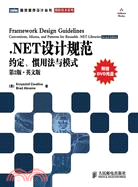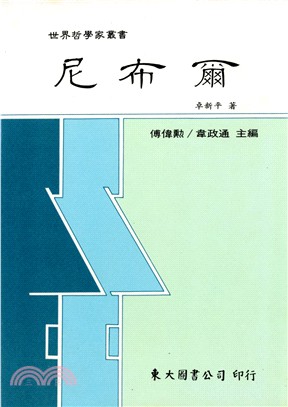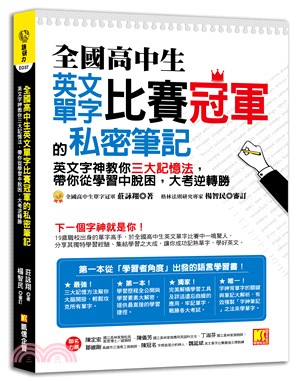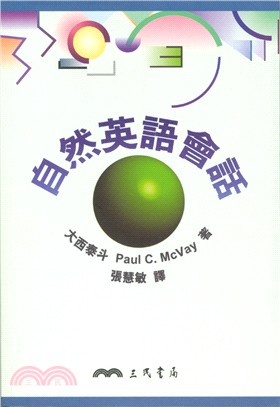人民幣定價:59 元
定價
:NT$ 354 元優惠價
:87 折 308 元
絕版無法訂購
相關商品
商品簡介
目次
商品簡介
本書關注直接影響框架可編程能力的設計問題,為框架設計師和廣大開發人員設計高質量的軟件提供了權威的指南,這一版更新至.NET 3.5。書中內容涉及框架設計的基本原則和規範,常用設計慣用法,為命名空間、類型、成員等框架各部分命名的規範,框架中常用設計模式的規範等。同時,書中添加了來自經驗豐富的框架設計師、業界專家及用戶給出的評注,為書中的許多規範增色不少。
本書為框架設計師必讀之作,也可用作.NET開發人員的技術參考書。
本書為框架設計師必讀之作,也可用作.NET開發人員的技術參考書。
目次
1 Introduction
1.1 Qualities of a Well-Designed Framework
1.1.1 Well-Designed Frameworks Are Simple
1.1.2 Well-Designed Frameworks Are Expensive to Design
1.1.3 Well-Designed Frameworks Are Full of Trade-Offs
1.1.4 Well-Designed Frameworks Borrow from the Past
1.1.5 Well-Designed Frameworks Are Designed to Evolve
1.1.6 Well-Designed Frameworks Are Integrated
1.1.7 Well-Designed Frameworks Are Consistent
2 Framework Design Fundamentals
2.1 Progressive Frameworks
2.2 Fundamental Principles of Framework Design
2.2.1 The Principle of Scenario-Driven Design
2.2.2 The Principle of Low Barrier to Entry
2.2.3 The Principle of Self-Documenting Object Models
2.2.4 The Principle of Layered Architecture
3 Naming Guidelines
3.1 Capitalization Conventions
3.1.1 Capitalization Rules for Identifiers
3.1.2 Capitalizing Acronyms
3.1.3 Capitalizing Compound Words and Common Terms
3.1.4 Case Sensitivity
3.2 General Naming Conventions
3.2.1 WordChoice
3.2.2 Using Abbreviations and Acronyms
3.2.3 Avoiding Language-Specific Names
3.2.4 Naming New Versions of Existing APIs
3.3 Names of Assemblies and DLLs
3.4 Names of Namespaces
3.4.1 Namespaces and Type Name Conflicts
3.5 Names of Classes, Structs, and Interfaces
3.5.1 Names of Generic Type Parameters
3.5.2 Names of Common Types
3.5.3 Naming Enumerations
3.6 Names of Type Members
3.6.1 Names of Methods
3.6.2 Names of Properties
3.6.3 Names of Events
3.6.4 Naming Fields
3.7 Naming Parameters
3.7.1 Naming Operator Overload Parameters
3.8 Naming Resources
4 Type Design Guidelines
4.1 Types and Namespaces
4.1.1 Standard Subnamespace Names
4.2 Choosing Between Class and Struct
4.3 Choosing Between Class and Interface
4.4 Abstract Class Design
4.5 Static Class Design
4.6 Interface Design
4.7 Struct Design
4.8 EnumDesign
4.8.1 Designing Flag Enums
4.8.2 Adding Values to Enums
4.9 Nested Types
4.10 Types and Assembly Metadata
5 MemberDesign
5.1 General Member Design Guidelines
5.1.1 Member Overloading
5.1.2 Implementing Interface Members Explicitly
5.1.3 Choosing Between Properties and Methods
5.2 Property Design
5.2.1 Indexed Property Design
5.2.2 Property Change Notification Events
5.3 Constructor Design
5.3.1 Type Constructor Guidelines
5.4 Event Design
5.4.1 Custom Event Handler Design
5.5 Field Design
5.6 Extension Methods
5.7 Operator Overloads
5.7.1 Overloading Operator ==
5.7.2 Conversion Operators
5.8 Parameter Design
5.8.1 Choosing Between Enum and Boolean Parameters
5.8.2 Validating Arguments
5.8.3 Parameter Passing
5.8.4 Members with Variable Number of Parameters
5.8.5 Pointer Parameters
6 Designing for Extensibility
6.1 Extensibility Mechanisms
6.1.1 Unsealed Classes
6.1.2 Protected Members
6.1.3 Events and Callbacks
6.1.4 Virtual Members
6.1.5 Abstractions (Abstract Types and Interfaces)
6.2 Base Classes
6.3 Sealing
7 Exceptions
7.1 Exception Throwing
7.2 Choosing the Right Type of Exception to Throw
7.2.1 Error Message Design
7.2.2 Exception Handling
7.2.3 Wrapping Exceptions
7.3 Using Standard Exception Types
7.3.1 ExceptCon and SystemExcept~on
7.3.2 AppL ~cat~onExcept~on
7.3.3 InvaL ~dOperat~onExceptCon
7.3.4 ArgumentExcept~on, ArgumentNuL LExcept~on, and ArgumentOutOfRangeExcept~on
7.3.5 NuL LReferenceExcept~on, IndexOutOfRangeExcept~on, and AccessVCoLatConExcept~on
7.3.6 StackOverfLowExcept~on
7.3.7 utOfMemoryExcept~on
7.3.8 ComExcept~on, SEHExceptCon, and Execut~onEng~ne-Exception
7.4 Designing Custom Exceptions
7.5 Exceptions and Performance
7.5.1 Tester-Doer Pattern
7.5.2 Try-Parse Pattern
8 Usage Guidelines
8.1 Arrays
8.2 Attributes
8.3 Collections
8.3.1 Collection Parameters
8.3.2 Collection Properties and Return Values
8.3.3 Choosing Between Arrays and Collections
8.3.4 Implementing Custom Collections
8.4 DateTime and DateTimeOffset
8.5 ICloneable
8.6 IComparable and IEquatable
8.7 IDisposable
8.8 Nuiiable
8.9 Object
8.9.1 Object. EquaLs
8.9.2 Object. GetHashCode
8.9.3 Object. ToStrlng271
8.10 Serialization
8.10.1 Choosing the Right Serialization Technology to Support
8.10.2 Supporting Data Contract Serialization
8.10.3 Supporting XML Serialization
8.10.4 Supporting Runtime Serialization
8.11 UrL 283
8.11.1 System. Urn. Implementation Guidelines
8.12 System.Xml Usage
8.13 Equality Operators
8.13.1 Equality Operators on Value Types
8.13.2 Equality Operators on Reference Types
9 Common Design Patterns
9.1 Aggregate Components
9.1.1 Component-Oriented Design
9.1.2 FactoredTypes
9.1.3 Aggregate Component Guidelines
9.2 The Async Patterns
9.2.1 Choosing Between the Async Patterns
9.2.2 Classic Async Pattern
9.2.3 Classic Async Pattern Basic Implementation Example
9.2.4 Event-Based Async Pattern
9.2.5 Supporting Out and Ref Parameters
9.2.6 Supporting Cancellation
9.2.7 Supporting Progress Reporting
9.2.8 Supporting Incremental Results
9.3 Dependency Properties
9.3.1 Dependency Property Design
9.3.2 Attached Dependency Property Design
9.3.3 Dependency Property Validation
9.3.4 Dependency Property Change Notifications
9.3.5 Dependency Property Value Coercion
9.4 Dispose Pattern
9.4.1 Basic Dispose Pattern
9.4.2 Finalizable Types
9.5 Factories
9.6 LINQ Support
9.6.1 Overview of LINQ
9.6.2 Ways of Implementing LINQ Support
9.6.3 Supporting LINQ through IEnumerabLe
9.6.4 Supporting LINQ through IOueryabLe~T~
9.6.5 Supporting LINQ through the Query Pattern
9.7 Optional Feature Pattern
9.8 Simulating Covariance
9.9 Template Method
9.10 Timeouts
9.11 XAML Readable Types
9.12 And in the End...
A C# Coding Style Conventions
A.1 General Style Conventions
A.1.1 Brace Usage
A.1.2 Space Usage
A.1.3 Indent Usage
A.1.4 Other 367
A.2 Naming Conventions
A.3 Comments
A.4 File Organization
B Using FxCop to Enforce the Framework Design Guidelines
B.1 What Is FxCop?
B.2 The Evolution of FxCop
B.3 How Does It Work?
B.4 FxCop Guideline Coverage
B.4.1 FxCop Rules for the Naming Guidelines
B.4.2 FxCop Rules for the Type Design Guidelines
B.4.3 FxCop Rules for Member Design
B.4.4 FxCop Rules for Designing for Extensibility
B.4.5 FxCop Rules for Exceptions
B.4.6 FxCop Rules for Usage Guidelines
B.4.7 FxCop Rules for Design Patterns
C Sample API Specification
Glossary
Suggested Reading List
Index
1.1 Qualities of a Well-Designed Framework
1.1.1 Well-Designed Frameworks Are Simple
1.1.2 Well-Designed Frameworks Are Expensive to Design
1.1.3 Well-Designed Frameworks Are Full of Trade-Offs
1.1.4 Well-Designed Frameworks Borrow from the Past
1.1.5 Well-Designed Frameworks Are Designed to Evolve
1.1.6 Well-Designed Frameworks Are Integrated
1.1.7 Well-Designed Frameworks Are Consistent
2 Framework Design Fundamentals
2.1 Progressive Frameworks
2.2 Fundamental Principles of Framework Design
2.2.1 The Principle of Scenario-Driven Design
2.2.2 The Principle of Low Barrier to Entry
2.2.3 The Principle of Self-Documenting Object Models
2.2.4 The Principle of Layered Architecture
3 Naming Guidelines
3.1 Capitalization Conventions
3.1.1 Capitalization Rules for Identifiers
3.1.2 Capitalizing Acronyms
3.1.3 Capitalizing Compound Words and Common Terms
3.1.4 Case Sensitivity
3.2 General Naming Conventions
3.2.1 WordChoice
3.2.2 Using Abbreviations and Acronyms
3.2.3 Avoiding Language-Specific Names
3.2.4 Naming New Versions of Existing APIs
3.3 Names of Assemblies and DLLs
3.4 Names of Namespaces
3.4.1 Namespaces and Type Name Conflicts
3.5 Names of Classes, Structs, and Interfaces
3.5.1 Names of Generic Type Parameters
3.5.2 Names of Common Types
3.5.3 Naming Enumerations
3.6 Names of Type Members
3.6.1 Names of Methods
3.6.2 Names of Properties
3.6.3 Names of Events
3.6.4 Naming Fields
3.7 Naming Parameters
3.7.1 Naming Operator Overload Parameters
3.8 Naming Resources
4 Type Design Guidelines
4.1 Types and Namespaces
4.1.1 Standard Subnamespace Names
4.2 Choosing Between Class and Struct
4.3 Choosing Between Class and Interface
4.4 Abstract Class Design
4.5 Static Class Design
4.6 Interface Design
4.7 Struct Design
4.8 EnumDesign
4.8.1 Designing Flag Enums
4.8.2 Adding Values to Enums
4.9 Nested Types
4.10 Types and Assembly Metadata
5 MemberDesign
5.1 General Member Design Guidelines
5.1.1 Member Overloading
5.1.2 Implementing Interface Members Explicitly
5.1.3 Choosing Between Properties and Methods
5.2 Property Design
5.2.1 Indexed Property Design
5.2.2 Property Change Notification Events
5.3 Constructor Design
5.3.1 Type Constructor Guidelines
5.4 Event Design
5.4.1 Custom Event Handler Design
5.5 Field Design
5.6 Extension Methods
5.7 Operator Overloads
5.7.1 Overloading Operator ==
5.7.2 Conversion Operators
5.8 Parameter Design
5.8.1 Choosing Between Enum and Boolean Parameters
5.8.2 Validating Arguments
5.8.3 Parameter Passing
5.8.4 Members with Variable Number of Parameters
5.8.5 Pointer Parameters
6 Designing for Extensibility
6.1 Extensibility Mechanisms
6.1.1 Unsealed Classes
6.1.2 Protected Members
6.1.3 Events and Callbacks
6.1.4 Virtual Members
6.1.5 Abstractions (Abstract Types and Interfaces)
6.2 Base Classes
6.3 Sealing
7 Exceptions
7.1 Exception Throwing
7.2 Choosing the Right Type of Exception to Throw
7.2.1 Error Message Design
7.2.2 Exception Handling
7.2.3 Wrapping Exceptions
7.3 Using Standard Exception Types
7.3.1 ExceptCon and SystemExcept~on
7.3.2 AppL ~cat~onExcept~on
7.3.3 InvaL ~dOperat~onExceptCon
7.3.4 ArgumentExcept~on, ArgumentNuL LExcept~on, and ArgumentOutOfRangeExcept~on
7.3.5 NuL LReferenceExcept~on, IndexOutOfRangeExcept~on, and AccessVCoLatConExcept~on
7.3.6 StackOverfLowExcept~on
7.3.7 utOfMemoryExcept~on
7.3.8 ComExcept~on, SEHExceptCon, and Execut~onEng~ne-Exception
7.4 Designing Custom Exceptions
7.5 Exceptions and Performance
7.5.1 Tester-Doer Pattern
7.5.2 Try-Parse Pattern
8 Usage Guidelines
8.1 Arrays
8.2 Attributes
8.3 Collections
8.3.1 Collection Parameters
8.3.2 Collection Properties and Return Values
8.3.3 Choosing Between Arrays and Collections
8.3.4 Implementing Custom Collections
8.4 DateTime and DateTimeOffset
8.5 ICloneable
8.6 IComparable and IEquatable
8.7 IDisposable
8.8 Nuiiable
8.9 Object
8.9.1 Object. EquaLs
8.9.2 Object. GetHashCode
8.9.3 Object. ToStrlng271
8.10 Serialization
8.10.1 Choosing the Right Serialization Technology to Support
8.10.2 Supporting Data Contract Serialization
8.10.3 Supporting XML Serialization
8.10.4 Supporting Runtime Serialization
8.11 UrL 283
8.11.1 System. Urn. Implementation Guidelines
8.12 System.Xml Usage
8.13 Equality Operators
8.13.1 Equality Operators on Value Types
8.13.2 Equality Operators on Reference Types
9 Common Design Patterns
9.1 Aggregate Components
9.1.1 Component-Oriented Design
9.1.2 FactoredTypes
9.1.3 Aggregate Component Guidelines
9.2 The Async Patterns
9.2.1 Choosing Between the Async Patterns
9.2.2 Classic Async Pattern
9.2.3 Classic Async Pattern Basic Implementation Example
9.2.4 Event-Based Async Pattern
9.2.5 Supporting Out and Ref Parameters
9.2.6 Supporting Cancellation
9.2.7 Supporting Progress Reporting
9.2.8 Supporting Incremental Results
9.3 Dependency Properties
9.3.1 Dependency Property Design
9.3.2 Attached Dependency Property Design
9.3.3 Dependency Property Validation
9.3.4 Dependency Property Change Notifications
9.3.5 Dependency Property Value Coercion
9.4 Dispose Pattern
9.4.1 Basic Dispose Pattern
9.4.2 Finalizable Types
9.5 Factories
9.6 LINQ Support
9.6.1 Overview of LINQ
9.6.2 Ways of Implementing LINQ Support
9.6.3 Supporting LINQ through IEnumerabLe
9.6.4 Supporting LINQ through IOueryabLe~T~
9.6.5 Supporting LINQ through the Query Pattern
9.7 Optional Feature Pattern
9.8 Simulating Covariance
9.9 Template Method
9.10 Timeouts
9.11 XAML Readable Types
9.12 And in the End...
A C# Coding Style Conventions
A.1 General Style Conventions
A.1.1 Brace Usage
A.1.2 Space Usage
A.1.3 Indent Usage
A.1.4 Other 367
A.2 Naming Conventions
A.3 Comments
A.4 File Organization
B Using FxCop to Enforce the Framework Design Guidelines
B.1 What Is FxCop?
B.2 The Evolution of FxCop
B.3 How Does It Work?
B.4 FxCop Guideline Coverage
B.4.1 FxCop Rules for the Naming Guidelines
B.4.2 FxCop Rules for the Type Design Guidelines
B.4.3 FxCop Rules for Member Design
B.4.4 FxCop Rules for Designing for Extensibility
B.4.5 FxCop Rules for Exceptions
B.4.6 FxCop Rules for Usage Guidelines
B.4.7 FxCop Rules for Design Patterns
C Sample API Specification
Glossary
Suggested Reading List
Index
主題書展
更多
主題書展
更多書展本週66折
您曾經瀏覽過的商品
購物須知
大陸出版品因裝訂品質及貨運條件與台灣出版品落差甚大,除封面破損、內頁脫落等較嚴重的狀態,其餘商品將正常出貨。
特別提醒:部分書籍附贈之內容(如音頻mp3或影片dvd等)已無實體光碟提供,需以QR CODE 連結至當地網站註冊“並通過驗證程序”,方可下載使用。
無現貨庫存之簡體書,將向海外調貨:
海外有庫存之書籍,等候約45個工作天;
海外無庫存之書籍,平均作業時間約60個工作天,然不保證確定可調到貨,尚請見諒。
為了保護您的權益,「三民網路書店」提供會員七日商品鑑賞期(收到商品為起始日)。
若要辦理退貨,請在商品鑑賞期內寄回,且商品必須是全新狀態與完整包裝(商品、附件、發票、隨貨贈品等)否則恕不接受退貨。
























